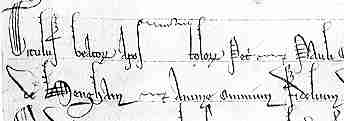 |
|
Samples
from a Mortuary Roll |
|
The
idea that scripts are highly uniform at any particular point in time and place can be counteracted
by examining a document containing a number of scripts which have been
added over a relatively short period of time. Mortuary rolls were sent
out by monastic foundations at the death of significant members of the
community. They were sent progressively around all houses of the same
order, and at each prayers were added for the soul of the deceased. A
mortuary roll in the British Library (Egerton MS 2849) was produced around
1230 at the death of Lucy, founding prioress of the priory of St Cross
and St Mary at Hedingham, Essex. It consists of a letter from her successor,
one Agnes, and tituli or prayers from 122
other religious houses. These were added as the roll made its progress
around the country over a short number of years. Samples of handwriting
from 10 of the appended prayers are shown here. They are taken from consecutive
entries. |
 |
| The
scribe for Boxgrave
Priory in Sussex employed an elaborate calligraphic
document hand
with extended wiggly ascenders
and a highly elaborated initial letter. |
 |
| The
next entry, from Southwyke Priory in Hampshire employs a charter
hand of a different character, with loopy ascenders and curly capitals. |
 |
| The
third entry, from Hyde Abbey, is of similar character to the previous. |
 |
| The
Abbey of St Mary at Winchester has employed something close to a Gothic
textura book
hand for their entry. |
 |
The
scribe for Old Minster at Winchester has used a neat Gothic charter hand with
calligraphic capitals, tall wiggly abbreviation marks as in the second word
beatorum, wedged ascenders and an extravagant
backsloping d. |
 |
| Romsey
Abbey in Hampshire has used what can only be described as a messy Gothic
script. |
 |
| With
Wilton Abbey in Wiltshire we return to a calligraphic charter hand with rather
curly elaborations and the backsloping d. |
 |
| The
entry from Shaftsbury Abbey resembles a Gothic book hand with a few extra
flourishes. |
 |
| The
exceptionally neat charter hand from Sherborne Abbey in Dorset is positively
Italian in character. |
 |
| The
scribe from Montacute in Somerset has gone all the way in producing an
elaborate calligraphic minuscule
similar to those of papal documents of high significance, including the large separation between
s and t in apostolorum in the top line. |
| Most
of the entries shown, barring perhaps one, have employed what one might
call posh writing, suitable for a highly ceremonial document. The differences
are in how they have interpreted them; some more like book hand, some
like chancery hands, some with an elegant ecclesiastical character. And
what is the story with Romsey Abbey? Did some ancient abbess with quavering
hands feel it was more important to pen the lines herself than to entrust
them to a mere scribe? Makes you want to have a look at the whole document. |
 Use BACK button of browser to return
Use BACK button of browser to return |
|









